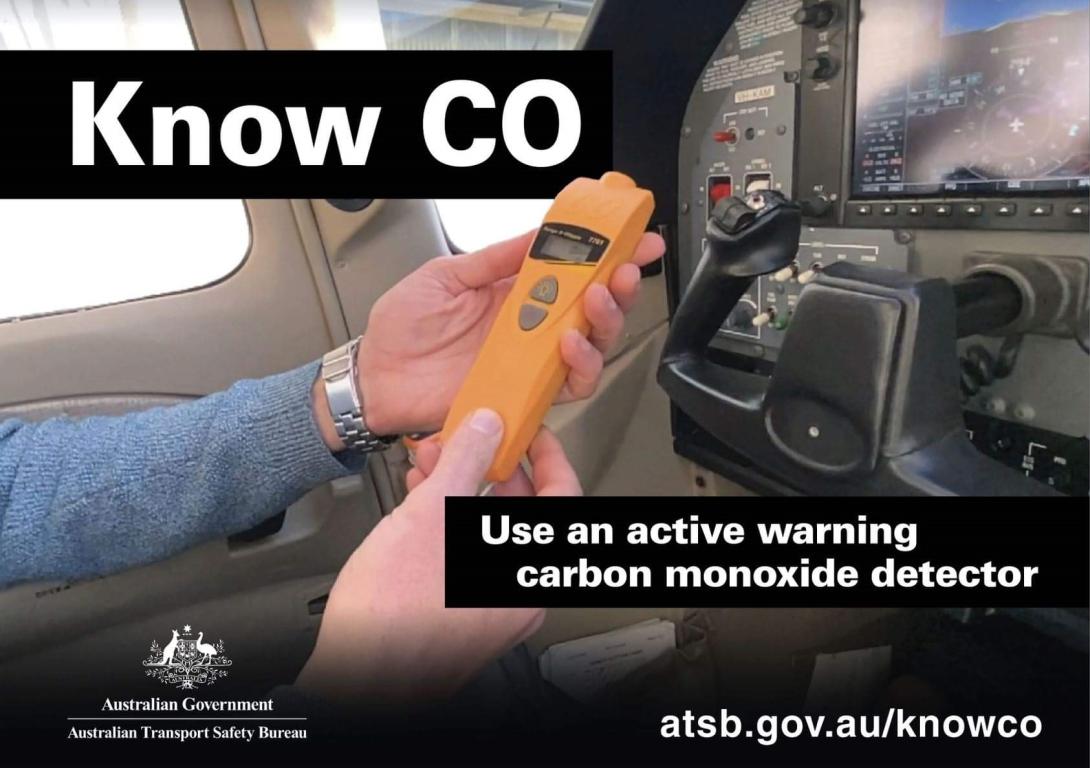
The Australian Transport Safety Bureau (ATSB) urges operators and owners of piston-engine aircraft to know about the presence of carbon monoxide (CO) by using an active warning detector.
CO is a colourless and odourless gas, and its presence may not be detected until the physical symptoms and cognitive effects present themselves. When inhaled, CO preferentially binds to haemoglobin, the oxygen carrying molecule in red blood cells. This creates carboxyhaemoglobin (COHb) compounds and prevents oxygen from binding to the molecule and being transported, resulting in oxygen starvation.
Symptoms can include breathlessness, confusion, disorientation and incapacitation.
Disposable chemical spot detectors, as commonly used in general aviation, may be effective in warning pilots of the presence of CO, but they have known limitations. Spot detectors are passive devices that relies on the pilot regularly monitoring it for discolouration. In addition, identifying a positive indication is also dependent on the detector being easily visible and accessible. Plus, these detectors do have a limited shelf-life when removed from their original packaging, which may be further affected by factors such as exposure to harsh direct sunlight, cleaning chemicals, and halogens.
The ATSB highlighted its concerns regarding exposure to CO when it issued two Safety Advisory Notices arising from its investigation into the collision with water of a DHC-2 Beaver aircraft in Jerusalem Bay, north of Sydney, in which the pilot and five passengers were fatally injured.
Toxicological testing of blood samples found the pilot and two passengers had elevated levels of CO. The levels detected were likely to have adversely affected the pilot’s ability to control the aircraft during the flight. The aircraft was fitted with a disposable chemical CO spot detector.
From the investigation, the ATSB published a Safety Advisory Notice, to piston-engine aircraft owners and pilots, reiterated the importance of the use of an active CO detector in the cabin. A second Safety Advisory Notice, to maintainers of piston-engine aircraft, highlighted the importance of the thorough inspection of exhaust systems and the timely repair or replacement of deteriorated components.
Additionally, the Civil Aviation Safety Authority (CASA) published an Airworthiness Bulletin, which encouraged operators and maintenance organisations to initiate a periodic CO detection check to measure the level of CO in the cabin at each annual or 100 hours-time in service (whichever occurs first), and each time the exhaust system or related components are disturbed.
The CO level entering the cabin must be less than 1 part in 20,000 parts of air (equivalent to 50 parts per million), derived from FAA FAR 23.83.
The ATSB's 'Know CO' campaign, launched in December 2021, encourages the use of CO detectors with an active warning. These inexpensive and widely available devices can provide pilots with the best opportunity to detect CO exposure before it adversely affects their ability to control the aircraft, or they become incapacitated.
It is worth noting that in July 2023, the UK Civil Aviation Authority (CAA) published its report into a study on how low-cost, commercial off-the-shelf, carbon monoxide CO detectors with attention-getting capabilities performed in a variety of general aviation (GA) aircraft and operating conditions.
Following a review in 2020 of accidents and incidents in the UK by the Air Accidents Investigation Board (AAIB) which identified two fatal accidents, each with two fatalities, and fifteen other events where CO may have been a causal factor over a 20-year period, a was established to qualitatively and quantitatively investigate how low-cost active detectors perform in UK GA aircraft over a full flying season, to better understand pilot’s user experience of flying with these devices and to evaluate CO levels in a cross-section of the fleet.
Findings from the study suggested the risk of CO exposure remains a persistent background threat throughout the year and is somewhat elevated during cold weather operations. Anecdotal test evidence suggested that active CO detectors designed for domestic use can function reasonably at typical recreational GA altitudes (up to 5,000 feet).
The report highlighted that while effective maintenance remains the first line of defence against CO and is the only way to avoid exposure, choosing to fly with an active CO detector is a decision pilots can make to protect themselves and their passengers from CO should maintenance fail.
With a wide range of active CO detectors on the market it has never been easier for pilots to find a device that suits their needs and budget. Active CO detectors are increasingly being built into other aviation equipment as standard, including ADS-B and headsets, making them ever more prevalent in GA aircraft. Additionally, some active CO detectors can be paired to personal electronic devices such as smartphones and smartwatches, increasing the likelihood of being alerted to elevated CO levels.
The report also highlighted the risk of CO poisoning may be known and understood by many pilots, the same cannot be said for consumers and third parties generally, who may fly in piston engine aircraft on a commercial or recreational basis. Pilots therefore should consider the significant safety benefits offered by flying with an active CO detector – it could not only save their life, but their passengers’ as well.
Read the report: CODE Trial Summary Report (caa.co.uk)
AOPA Real Pilot Story: Hidden Hazard
Flying his Mooney, Dan Bass was overcome by CO poisoning and lost consciousness while airborne. He recounts the dreadful accident and his miraculous survival waking up in a snow-covered field in the bitter north American February cold.
New Zealand Airline Academy sees immediate value of electronic CO detectors
In this CAA NZ article, The value of an electronic CO detector | aviation.govt.nz, the Chief Flying Instructor of the New Zealand Airline Academy talks about Installing electronic CO detectors across its entire training fleet almost immediately saved two lives.


